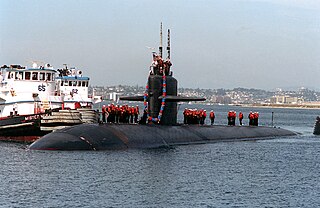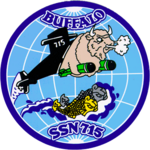
USS Omaha (SSN-692), a Los Angeles-class submarine, was the third ship of the United States Navy to be named for Omaha, Nebraska. The contract to build her was awarded to the Electric Boat Division of General Dynamics Corporation in Groton, Connecticut on 31 January 1971 and her keel was laid down on 27 January 1973. She was launched on 21 February 1976 sponsored by Mrs. Victoria Kuncl Hruska, wife of Senator Roman L. Hruska, and commissioned on 11 March 1978.

USS Los Angeles (SSN-688), lead ship of her class of submarines, was the fourth ship of the United States Navy to be named for Los Angeles, California. The contract to build her was awarded to Newport News Shipbuilding and Dry Dock Company in Newport News, Virginia on 8 January 1971 and her keel was laid down on 8 January 1972. She was launched on 6 April 1974 sponsored by Anne Armstrong, and commissioned on 13 November 1976. She hosted President Jimmy Carter and the First Lady on 27 May 1977 for an at-sea demonstration of her capabilities. In 2007 she was the oldest submarine in active service with the United States Navy. The Navy decommissioned Los Angeles on 23 January 2010, in the Port of Los Angeles, Los Angeles, California, her namesake city.

USS Louisville (SSN-724), a Los Angeles-class submarine, is the fourth ship of the United States Navy to be named for Louisville, Kentucky. The contract to build her was awarded to the Electric Boat Division of General Dynamics Corporation in Groton, Connecticut, on 11 February 1982 and her keel was laid on 24 September 1984. She was launched on 14 December 1985—sponsored by Mrs. Betty Ann McKee, wife of Admiral Kinnaird McKee, Director of Naval Nuclear Propulsion —and commissioned on 8 November 1986 with Captain Charles E. Ellis in command.

USS Hawkbill (SSN-666), a Sturgeon-class attack submarine, was the second ship of the United States Navy to be named for the hawksbill, a large sea turtle. The name perpetuated the inadvertent misspelling of "hawksbill" in the naming of the first ship of that name, USS Hawkbill (SS-366), a Balao-class submarine launched in 1944. USS Hawkbill (SSN-666) was the eighteenth of 39 Sturgeon-class nuclear-powered submarines that were built.

USS San Francisco (SSN-711) is a Los Angeles-class nuclear submarine, the third ship or boat of the United States Navy to be named for San Francisco, California.

USS Pintado (SSN-672), a short hull Sturgeon-class attack submarine, was the second ship of the United States Navy to be named for the pintado, a large mackerel-like fish, whose elongated spots suggested the Spanish language word meaning "painted."

USS Tautog (SSN-639), a Sturgeon-class attack submarine, was the second ship of the United States Navy to be named for the tautog, a wrasse commonly found along the Northern Atlantic coast. The submarine was in service from 17 August 1968 to 31 March 1997.

USS Aspro (SSN-648) was a Sturgeon-class submarine launched in 1969 and decommissioned in 1995. Scrapping was completed in 2000.

USS Puffer (SSN-652), a Sturgeon-class nuclear attack submarine, was the second ship of the United States Navy to be named for the pufferfish, a saltwater fish with toxic spines that can inflate its body with water or air and is one of the most poisonous vertebrates in the world.

USS Drum (SSN-677), a Sturgeon-class attack submarine, was the second ship of the United States Navy to be named for the drum, also known as the croaker or hardhead, any of various fishes of the Sciaenidae family, capable of making a drumming noise and best known on the Atlantic coast of North America.

USS Columbia (SSN-771) is the 21st flight III, or Improved (688i) Los Angeles-class attack submarine of the United States Navy. Commissioned in 1995, the submarine is assigned to Submarine Squadron 7 and homeported in Joint Base Pearl Harbor-Hickam.

USS Asheville (SSN-758), is a Los Angeles-class nuclear powered fast attack submarine. She is the fourth vessel of the United States Navy to be named for Asheville, North Carolina. The contract to build her was awarded to Newport News Shipbuilding and Dry Dock Company in Newport News, Virginia on 26 November 1984 and her keel was laid down on 9 January 1987. She was launched on 24 February 1990, sponsored by Mrs. Dorothy Helms, and commissioned on 28 September 1991.

USS Bremerton (SSN-698), a Los Angeles-class submarine, is the second vessel of the United States Navy to be named for Bremerton, Washington. The contract to build her was awarded to the Electric Boat Division of General Dynamics Corporation in Groton, Connecticut on 24 January 1972 and her keel was laid down on 8 May 1976. She was launched on 22 July 1978 sponsored by Mrs. Helen Jackson, wife of Henry M. Jackson, and commissioned on 28 March 1981.

USS Olympia (SSN-717) is a Los Angeles-class submarine of the United States Navy. She is the 30th Los Angeles class nuclear powered fast attack submarine.

USS Chicago (SSN-721) is a Los Angeles-class submarine, the fourth ship of the United States Navy to be named for the city of Chicago, Illinois. The contract to build her was awarded to Newport News Shipbuilding and Dry Dock Company in Newport News, Virginia on 13 August 1981 and her keel was laid down on 5 January 1983. She was launched on 13 October 1984 sponsored by Mrs. Vicki Ann Paisley, wife of Melvyn R. Paisley assistant Secretary of the Navy, and commissioned on 27 September 1986.

USS Key West (SSN-722), a Los Angeles-class submarine, is the third ship of the United States Navy to be named after Key West, Florida.

USS Columbus (SSN-762) is a Los Angeles-class nuclear powered fast attack submarine and the second vessel of the United States Navy to be named for Columbus, Ohio. The contract to build her was awarded to the Electric Boat Division of General Dynamics Corporation in Groton, Connecticut, on 21 March 1986 and her keel was laid down on 9 January 1991. She was launched on 1 August 1992 sponsored by Mrs. Margaret DeMars, wife of Admiral Bruce DeMars and commissioned on 24 July 1993.

USS Santa Fe (SSN-763), a Los Angeles-class submarine, is the second ship of the United States Navy to be named for Santa Fe, New Mexico. The contract to build her was awarded to the Electric Boat Division of General Dynamics Corporation in Groton, Connecticut on 21 March 1986 and her keel was laid down on 9 July 1991. She was launched on 12 December 1992 sponsored by Mrs. Joy Johnson, and commissioned on 8 January 1994, with Commander Rodger P. Krull in command.

Submarine Squadron 3 was a squadron of submarines of the United States Navy based at Joint Base Pearl Harbor–Hickam, Pearl Harbor, HI which was disestablished in 2012.

Submarine Squadron 15 is a squadron of submarines of the United States Navy based at Naval Base Guam.























